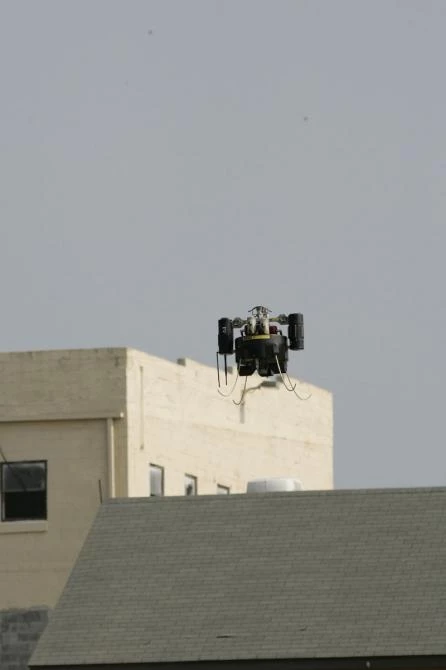October 26, 2005 As the conflicts in Afghanistan and Iraq have unfolded, one of the new stars in the theatre of battle has been the Unmanned Aerial Vehicle (UAV). As each new conflict redefines war based on the technologies coming of age at that time, the Iraq campaign has seen the coming of age of the UAV in its many wonderous forms. It is the most-requested capability among combatant commanders and in the last 18 months, UAV numbers in Iraq have jumped from fewer than 100 to more than 400 and there are now nearly 600 UAVs in the Afghanistan and Iraq theatres. Even more interesting is the dizzying array of unmanned aircraft used in traditional intelligence, surveillance and reconnaissance UAV roles. Now we’re set to see UAVs get smaller – much smaller. The United States Future Combat Systems (FCS) program recently passed a significant milestone in its progress toward selecting a Class I Unmanned Aerial Vehicle (UAV) system. The MAV has achieved a technology readiness level 6 and is now ready to begin transitioning the technology to the FCS program as an affordable backpackable systems suitable for dismounted soldier, Marine, and Special Forces missions. It will focus on the development of lift augmented ducted fan MAVs to accomplish unique military missions, particularly the hover and stare capability in restricted (e.g urban) environments to provide real-time combat information.
The system will also be employable in a variety of warfighting environments (for example: in complex topologies such as mountainous terrain; urban areas; confined spaces; and high concentrations of civilians). The initial MAV technology development program focused on the technologies and components required to enable flight at small scales, including flight control, power and propulsion, navigation and communications. The MAV ACTD program is intended to get DARPA-developed small, VTOL UAVs rapidly into the hands of the users for evaluation and evolution of the technologies; development of tactics, techniques and procedures; and to provide a residual operational capability to active duty forces. The FCS MAV technology is planned for transition to the Army during FY 2007.
The unique attribute of the system is the ability to “perch and stare,” which is the ability to land and continue to collect data. These systems are a cross between an unmanned air vehicle and an unattended ground sensor. While the vehicle is sitting collecting data (like an unattended ground sensor), it uses two orders-of-magnitude less fuel than while flying (i.e., one hour flight time uses the same fuel as one week of “perch and stare”). However, unlike unattended ground sensors, the MAV retains the ability to take-off and fly to another location, or to follow something of interest that is moving.
The announcement was made last week by Boeing and partner Science Applications International Corporation (SAIC), the Lead Systems Integrator team for the U.S. Army's FCS program.
The Micro Air Vehicle (MAV), developed by Honeywell under a two-phased Defense Advanced Research Projects Agency advanced concept technology development contract, has achieved a technology readiness level 6. The readiness level is based on recent successes during government acceptance tests and pre-experimentation flights. The level 6 designation is consistent with FCS requirements to begin transitioning the technology to the FCS program.
“The Micro Air Vehicle has flown more than 200 successful flights, including flying in a representative urban environment,” said Mark Franzblau, director, FCS Unmanned Aerial Vehicle system development. “We are confident it will continue to meet or exceed the goals of DARPA's contract and eventually transition to FCS as the preferred Class I UAV platform.”
The Micro Air Vehicle contract provides critical development in two key technology areas essential to meeting FCS Class I Unmanned Aerial Vehicle requirements: a ducted fan design providing hover and stare capability coupled with a small heavy fuels engine. The FCS program will continue to work with DARPA and Honeywell to transition the heavy fuel engine technology as it matures through the remainder of the DARPA contract.
Leveraging DARPA's investment in the Micro Air Vehicle technology, Boeing issued a system engineering contract in December 2004 to Honeywell to conduct a gap analysis identifying what additional development was required to transition the DARPA vehicle to an FCS-compliant Class I UAV system. Under the extended, nearly-three-million-dollar contract announced this week, Honeywell will continue the systems engineering analyses leading to a System Functional Review in March 2006. Following a successful review, Boeing intends to award a Class I UAV System Development and Demonstration contract to Honeywell. The development and demonstration phase will continue through FY2014 and will include the development and flight test of unmanned, autonomous vehicle prototypes.
The FCS Class I Unmanned Aerial Vehicle is one of four classes of FCS Unmanned Aerial Vehicle systems that are organic to platoon, company, battalion and brigade echelons and form the airborne component of the FCS network providing protection and information for troops on the ground. Together, they constitute four of the 18 systems, which, together with the network and the soldier, will make up FCS.
The FCS Class I Unmanned Aerial Vehicle will be used for reconnaissance, security and target acquisition operations in open, rolling, complex and urban terrain. Each system – comprising two air vehicles, a dismounted control device and associated ground support equipment – will be carried by selected platforms and dismounted soldiers, and will use autonomous flight and navigation with vertical take-off and landing and recovery capability.









